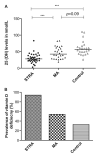Relationship between serum vitamin D, disease severity, and airway remodeling in children with asthma
- PMID: 21908411
- PMCID: PMC3471128
- DOI: 10.1164/rccm.201107-1239OC
Relationship between serum vitamin D, disease severity, and airway remodeling in children with asthma
Abstract
Rationale: Little is known about vitamin D status and its effect on asthma pathophysiology in children with severe, therapy-resistant asthma (STRA).
Objectives: Relationships between serum vitamin D, lung function, and pathology were investigated in pediatric STRA.
Methods: Serum 25-hydroxyvitamin D [25(OH)D(3)] was measured in 86 children (mean age, 11.7 yr): 36 with STRA, 26 with moderate asthma (MA), and 24 without asthma (control subjects). Relationships between 25(OH)D(3), the asthma control test (ACT), spirometry, corticosteroid use, and exacerbations were assessed. Twenty-two of 36 children with STRA underwent fiberoptic bronchoscopy, bronchoalveolar lavage, and endobronchial biopsy with assessment of airway inflammation and remodeling.
Measurements and main results: 25(OH)D(3) levels (median [IQR]) were significantly lower in STRA (28 [22-38] nmol/L) than in MA (42.5 [29-63] nmol/L) and control subjects (56.5 [45-67] nmol/L) (P < 0.001). There was a positive relationship between 25(OH)D(3) levels and percent predicted FEV(1) (r = 0.4, P < 0.001) and FVC (r = 0.3, P = 0.002) in all subjects. 25(OH)D(3) levels were positively associated with ACT (r = 0.6, P < 0.001), and inversely associated with exacerbations (r = -0.6, P < 0.001) and inhaled steroid dose (r = -0.39, P = 0.001) in MA and STRA. Airway smooth muscle (ASM) mass, but not epithelial shedding or reticular basement membrane thickness, was inversely related to 25(OH)D(3) levels (r = -0.6, P = 0.008). There was a positive correlation between ASM mass and bronchodilator reversibility (r = 0.6, P = 0.009) and an inverse correlation between ASM mass and ACT (r = -0.7, P < 0.001).
Conclusions: Lower vitamin D levels in children with STRA were associated with increased ASM mass and worse asthma control and lung function. The link between vitamin D, airway structure, and function suggests vitamin D supplementation may be useful in pediatric STRA.
Figures





Comment in
-
Vitamin D and asthma: another dimension.Am J Respir Crit Care Med. 2011 Dec 15;184(12):1324-5. doi: 10.1164/rccm.201109-1737ED. Am J Respir Crit Care Med. 2011. PMID: 22174108 No abstract available.
-
Glucocorticosteroids are potential confounders in studies of vitamin D and asthma.Am J Respir Crit Care Med. 2012 Jun 1;185(11):1245; author reply 1245-6. doi: 10.1164/ajrccm.185.11.1245. Am J Respir Crit Care Med. 2012. PMID: 22661526 No abstract available.
References
-
- Bush A, Zar HJ. WHO universal definition of severe asthma. Curr Opin Allergy Clin Immunol. 2011;11:115–121. - PubMed
-
- American Thoracic Society Proceedings of the ATS workshop on refractory asthma: current understanding, recommendations, and unanswered questions. Am J Respir Crit Care Med. 2000;162:2341–2351. - PubMed
-
- Chung KF, Godard P, Adelroth E, Ayres J, Barnes N, Barnes P, Bel E, Burney P, Chanez P, Connett G, et al. ERS Task Force on Difficult/Therapy-resistant Asthma. European Respiratory Society Difficult/therapy-resistant asthma: the need for an integrated approach to define clinical phenotypes, evaluate risk factors, understand pathophysiology and find novel therapies. Eur Respir J. 1999;13:1198–1208. - PubMed
-
- Holick MF. Vitamin D deficiency. N Engl J Med. 2007;357:266–281. - PubMed
Publication types
MeSH terms
Substances
Grants and funding
LinkOut - more resources
Full Text Sources
Other Literature Sources
Medical

